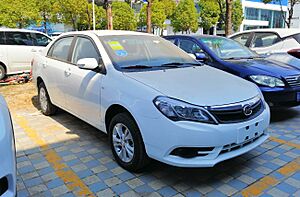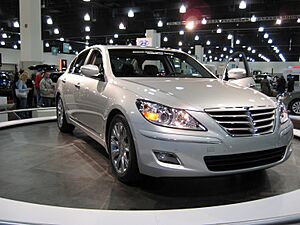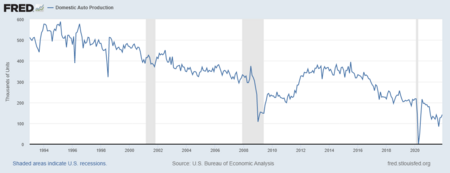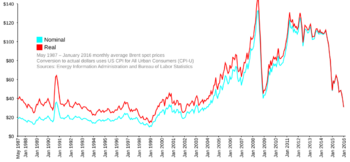2008–2010 automotive industry crisis facts for kids
The 2008–2010 car industry crisis was a big problem for car makers around the world. It happened during the 2007–2008 financial crisis and the Great Recession. This crisis hit car companies in Europe and Asia. But it was felt most strongly by car makers in America and Canada.
The car industry faced problems because fuel prices went way up. This made people not want to buy big sport utility vehicles (SUVs) and pickup trucks. These vehicles use a lot of fuel. American car companies like General Motors, Ford, and Chrysler made a lot of money from selling these big vehicles. But when fuel prices rose, sales dropped. By 2008, the situation became very serious. The financial crisis also made the cost of materials higher.
Car companies from Asia, Europe, North America, and other places tried new ways to get people to buy cars. Most companies saw their sales fall a lot. Big car makers, including the American "Big Three" and Toyota, offered big discounts. The American companies were criticized because their cars were not good for high fuel prices. People in North America started buying smaller, cheaper, and more fuel-efficient cars from Japan and Europe.
Asia's Car Industry Challenges
China's Response
In 2008, the Chinese government lowered taxes on cars. They did this to help car sales that were slowing down.
Also in 2008, the BYD F3 compact car came out as a plug-in hybrid version. It was the first car of its kind made for regular buyers.
In January 2009, the Chinese car maker Chery reported its best monthly sales ever.
India's Car Market
The State Bank of India lowered interest rates on car loans in February 2009. They did this because fewer cars were being made.
In early 2009, Tata Motors started a big advertising campaign for its new car, the Tata Nano. This car was called "the people's car." The company hoped its low price would make people buy it, even with the money problems.
Japan's Car Companies
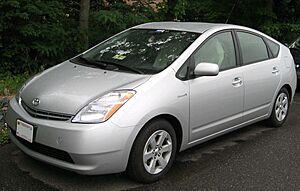
In summer 2008, with high gas prices and a weak US economy, Toyota's sales dropped a lot. This was similar to what happened to the American "Big Three." For Toyota, this was mainly because sales of its Tundra pickup were slow. There were also not enough fuel-efficient cars like the Prius and Corolla.
Toyota then decided to stop making trucks at some plants. They also shifted other factories to make cars that people wanted more. On December 22, 2008, Toyota said it expected to lose money for the first time in 70 years. Toyota's sales fell by 33.9 percent, and Honda Motor's sales dropped by 31.6 percent.
On December 5, 2008, Honda Motor Company said it would leave Formula One racing right away. This was because of the 2008 money crisis. Honda also thought it might have to cut jobs for part-time and contract workers. Top managers' bonuses were also reviewed, and directors took a 10 percent pay cut.
Nissan, another big Japanese car maker, also said it would make fewer cars. They planned to cut production by 80,000 vehicles in early 2009.
In December 2008, Suzuki, Japan's fourth-largest car maker, said it would cut production by about 30,000 cars. This was due to less demand. The company expected its first profit drop in eight years.
On December 16, 2008, Fuji Heavy Industries, which makes Subaru cars, said it would leave the World Rally Championship. This decision was due to the "widespread economic downturn." It came one day after Suzuki also left the sport.
Toyota cut its profit predictions on December 22, 2008, because sales were falling. The company expected a small profit of US$555 million for the year ending March 2009. Toyota had first expected a huge profit of $13.9 billion. Their sales in the United States and Europe were down 34 percent. Toyota President Katsuaki Watanabe said the global economy's impact was "faster, wider and deeper than expected." He called the change a "critical scale that comes once in a hundred years."
Toyota asked the Japanese government for loans because it faced its first loss in almost sixty years. On November 4, 2009, Toyota also announced it was leaving Formula One racing.
South Korea's Success
South Korean car makers generally made more money than US and Japanese companies. They grew strongly even when markets were down. Despite the global slowdown, Hyundai-Kia became the world's 5th largest car maker in 2008. They passed Honda Motor. Hyundai-Kia kept growing quickly in 2009. They passed Ford Motor to become the world's 4th largest car maker.
Hyundai-Kia's success was unusual when most car makers saw sales fall. GM even went bankrupt. Hyundai-Kia used the car crisis to their advantage. They made good quality, well-designed, and affordable cars. They built modern factories in countries like Slovakia, the United States, and China. These factories were set up to make cars for local markets. For example, the Kia Cee'd was designed in Germany and built in Slovakia.
For many South Korean car makers, this crisis became a chance to grow. Hyundai even offered customers who lost their jobs a refund if they returned a new car. Their success came from making fuel-efficient, well-equipped, and affordable cars. These cars also had good warranties. Cars like the Kia Picanto, Kia Cee'd, and Hyundai i30 attracted buyers worldwide. This happened during a time of economic problems, rising oil prices, and environmental worries. South Korean car makers had an advantage over expensive luxury cars and SUVs from other countries.
From late 2008 to early 2009, the South Korean currency was very weak. This made South Korean exports much cheaper in key markets like the US and Japan. Also, their brand became more well-known. This was thanks to new luxury cars like the Hyundai Genesis. These cars received very good reviews. Hyundai's brand grew by 9% in 2008. They even advertised during the Super Bowl in the United States.
However, South Korean car makers were not completely safe from the crisis. In December 2008, Hyundai Motor Company started making fewer cars. This was at plants in the U.S., China, Slovakia, India, and Turkey. They missed their goal of 4.8 million cars for 2008. They also froze wages for office workers and shortened factory hours.
South Korea's fourth-largest car maker, SsangYong Motor, was hit hardest. This company makes mostly large, fuel-hungry SUVs. They lost money for four quarters in a row by the end of 2008. Their sales dropped 63 percent from July to September. Their factories were idle since December 17 to reduce unsold cars.
Taiwan's Car Industry
As part of Luxgen's plan to sell cars worldwide, their first overseas sale was in Oman in 2010. They planned to focus on markets in the Middle East, Latin America, Russia, China, and Southeast Asia.
Europe's Car Industry
In Europe, car sales also dropped a lot. Governments in France, Germany, and Italy thought about giving money to the car industry. German Foreign Minister Frank-Walter Steinmeier and Luxembourg's Prime Minister Jean-Claude Juncker talked about a common rescue plan for all EU countries.
After six years of falling sales, car registrations in Europe went up in February 2014. Sales increased as expected due to lower prices and a better economy.
France's Car Makers
On November 20, 2008, the French car maker PSA Peugeot Citroen said sales would fall by at least 10% in 2009. This was after a 17% drop in the last three months of 2008. As a result, they planned to cut 2,700 jobs. On February 11, 2009, PSA announced it would cut 11,000 jobs worldwide. However, none of these cuts were expected in France.
Renault announced a profit of 599 million euros for 2008. This was a 78% drop from 2007. European sales fell 4%, and worldwide sales fell 7%. This made Renault give up its growth goals for 2009. Still, Renault was one of the few car makers to make a profit.
France and Germany Work Together
On November 24, 2008, French President Nicolas Sarkozy and German Chancellor Angela Merkel agreed to help their countries' car industries. They said detailed plans would be announced soon.
Italy's Fiat

On December 16, 2008, Fiat in Italy said it would extend temporary factory closures by a month. The Pomigliano d'Arco plant, which makes Alfa Romeo cars, would close for four weeks. However, on February 20, 2009, Fiat said its plant closures would be shorter. This was because the Italian government helped the car industry. The company also predicted that sales in Europe would drop by 14 percent in 2009.
On January 20, 2009, Fiat announced a deal to buy 35% of Chrysler. Fiat would not pay with money. Instead, Chrysler would use some of Fiat's fuel-efficient technologies. Chrysler promised to make nine Fiat-based vehicles by 2010. Fiat would also get access to Chrysler's dealerships in the U.S. There, smaller cars like the Fiat Grande Punto might do well.
On January 22, 2009, Fiat announced a 19% drop in money coming in during late 2008. Italian Prime Minister Silvio Berlusconi said the government would meet to talk about the issue.
Russia's Car Industry
Russia's car industry was hit hard by the economic problems. Car production dropped from 1,470,000 cars in 2008 to only 597,000 in 2009. Truck production also fell a lot.
In late 2008, the Russian government put in place measures worth $5 billion to help the industry. This included $2 billion to help struggling companies. It also included $3 billion in loans for people buying Russian cars. Prime Minister Vladimir Putin said this was important to save jobs. Taxes on imported foreign cars and trucks were raised a lot. These higher taxes led to protests in Russian cities.
The most helpful step taken by the Russian government was a "car scrappage scheme" in March 2010. Under this plan, people buying new cars could get a discount. As a result, sales for Russia's largest car maker, Avtovaz, doubled in mid-2010. The company started making a profit again.
Spain's SEAT
Spanish car maker SEAT (part of the Volkswagen Group) cut production at its Martorell plant by 5% on October 7, 2008. This was because sales had fallen. This affected 750 workers and lasted until July 2009.
Sweden's Volvo and Saab
On December 11, 2008, the Swedish government gave its car makers, Volvo and Saab, SEK 28 billion (about 3.5 billion USD). The two companies had asked for help. They faced money problems because their US owners, Ford and General Motors, were struggling. The plan included up to SEK 20 billion in loan guarantees and up to SEK 5 billion in rescue loans.
On February 18, 2009, General Motors warned that Saab might fail within ten days. This would happen if the Swedish government did not step in. On February 20, an administrator was appointed to help Saab become independent from General Motors. General Motors confirmed it wanted to sell Saab. In Sweden, 140,000 people work in the car industry. They make up 15% of the country's exports.
United Kingdom's Car Industry
In the United Kingdom, Jaguar Land Rover asked the government for a $1.5 billion loan. This was to help them deal with the money crisis. The company is now owned by Tata Motors.
On December 22, 2008, Tata said it would put "tens of millions" of pounds into Jaguar Land Rover. British Prime Minister Gordon Brown also said he would help the car industry in the U.K.
On January 8, 2009, Nissan UK announced it would cut 1200 jobs at its Washington factory. This was despite the factory being called the most efficient in Europe.
General Motors' UK company, Vauxhall Motors, has two main sites in the UK. One is a factory in Ellesmere Port, and the other is its headquarters in Luton. It was not known if these plants would be affected by GM's cuts. GM later canceled a plan to sell Vauxhall and its sister company, Opel, to another company.
UK bus maker Optare received a big order in November 2008. This order was for 53 buses, worth over £6 million. It helped secure 500 jobs at the company's factory in Cross Gates, Leeds.
UK van maker LDV Group asked the UK government for a £30 million loan. This was to help its managers buy the company. The loan was refused. LDV later said it had a future and wanted to be the first to make many electric vans. Production at LDV's factory in Birmingham stopped in December 2008 due to low demand. No buyout happened, and LDV closed down on October 15, 2009.
The UK government also started a "scrappage incentive scheme." This was to help the struggling car industry. Older cars could be scrapped for a £2000 discount on a new car. The government paid half, and the dealer paid the other half. This scheme ended on March 31, 2010.
North America's Car Industry
Canada's Challenges
The Canadian car industry was very connected to the U.S. industry. This was because of trade agreements. So, Canada faced similar problems.
United States' Crisis
The crisis in the United States is mostly known for the government helping General Motors and Chrysler. Ford got a credit line in case they needed a loan. Car sales dropped in the United States. This affected both US and foreign car makers.
The government loans led to more examination of the US car industry. People criticized their car types, quality, high worker wages, and job programs. In 2009, 37% of Americans supported the government's help for the car industry. By 2012, 56% supported it. Chrysler had to file for bankruptcy in April 2009, and GM did so in May.
The "Big Three" US car makers' share of the market fell from 70% in 1998 to 53% in 2008. But global sales increased, especially in Asia and Europe. The US car industry had made a profit every year since 1955, except after recessions and wars.
Facing money losses, the Big Three closed many factories and cut many jobs. GM and Ford spun off some parts of their companies. These parts makers also faced problems. General Motors alone lost an estimated $51 billion in the three years before the financial crisis.
The 2005 Harbour Report said that Toyota had a cost advantage of $350 to $500 per car over North American makers. The United Auto Workers union agreed to lower wages for new workers in 2007. However, most of these changes only applied to new hires. Older workers still had contracts from a long time ago.
To make more money, the Detroit car makers made deals with unions to lower wages. They also made promises about pensions and health care. GM, for example, used to pay for all health insurance for its workers and retirees. With many of these plans not having enough money, companies tried to offer retirement packages. They also made deals to move pension duties to a separate fund. Still, Japanese car makers, with younger US workers, had a cost advantage.
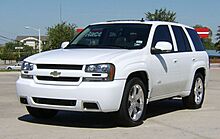
Despite their long history, many old car models were stopped or only sold to fleets. GM, Ford, and DaimlerChrysler moved away from smaller cars. They focused on leading the "SUV Craze." Since the late 1990s, more than half of their profits came from light trucks and SUVs. They often could not make money on compact cars unless buyers chose extra features. An expert said that car makers needed to sell ten small cars to make the same profit as one big vehicle. SUV sales peaked in 1999 and have not returned to that level due to higher gas prices.
The Detroit Big Three were slower to bring new cars to market than foreign competitors. They also struggled with how people saw their initial quality, even with improvements.
Falling sales meant the Big Three's factories were not used fully. GM's plants were at 85% capacity in November 2005. This was much lower than Asian competitors. This was only kept up by offering cash deals and cheap leases. Discounts and special financing boosted sales but used up the car makers' money. The housing market crisis and high oil prices in 2008 made big trucks and SUVs less popular. Car makers had to keep offering big discounts to sell extra cars. Chrysler and GM stopped offering leases on most of their cars in 2008.
In September 2008, the Big Three asked for $50 billion to pay for health care and avoid bankruptcy. Congress worked out a $25 billion loan. By December, President Bush agreed to an emergency bailout of $17.4 billion. This money was given out in early 2009. In early 2009, the chance of GM and Chrysler avoiding bankruptcy became smaller. This was as new information about their 2008 losses came in. In the end, poor management forced Chrysler and General Motors into bankruptcy. Chrysler filed for bankruptcy on May 1, 2009, followed by General Motors a month later.
On June 2, General Motors announced it would sell the Hummer brand of off-road vehicles. This deal later fell through. Later, GM said it would stop making its Hummer, Saturn, and Pontiac cars by the end of the 2009 model year.
How Environmental Goals Affected Car Sales
Concerns about the environment and carbon emissions made people care more about fuel efficiency. In his book An Inconvenient Truth, Al Gore criticized the Big Three. He said they kept trying to sell big, fuel-hungry cars, even though fewer people were buying them. For example, Japan requires cars to get about 45 miles per gallon. China requires about 35 miles per gallon. The European Union requires about 47 miles per gallon by 2012. In comparison, US cars only needed to get about 25 miles per gallon at that time.
The Big Three received $25 billion in government loans in October 2008. This was to help them update their factories. The goal was to meet new fuel-efficiency standards of at least 35 miles per gallon by 2020. These loans were meant to help car makers make "advanced technology vehicles."
How Oil Prices and Money Problems Affected Sales
In 2008, several big problems pushed the Big Three close to bankruptcy. In recent years, the Big Three had made SUVs and large pickups. These were much more profitable than smaller, fuel-efficient cars. Car makers made 15% to 20% profit on an SUV. They made 3% or less on a car. When gasoline prices went above $4 per gallon in 2008, Americans stopped buying big vehicles. This made the Big Three's sales and profits drop sharply.
The 2007–2008 financial crisis also played a part. GM could not get money to buy Chrysler. Sales fell even more as it became harder for people to get bank loans to buy a car. In 2007, nearly 2 million new US cars were bought with money from home equity loans. This kind of funding was much less available in 2008. Also, stock prices fell as investors worried about bankruptcy. GM's shares fell below 1946 levels. The unstable job market and people's money worries also made them not want to take on new car loans. This affected almost all major car makers.
The industry could make 17 million cars a year. But sales in 2008 dropped to only 10 million cars made in the US and Canada. All car makers and their many suppliers make up 2.3% of the US economy. This was down from 3.1% in 2006 and 5% in the 1990s. About 20% of the entire US manufacturing sector is still linked to the car industry.
By December 19, 2008, oil prices had fallen to $33.87 per barrel. But the car crisis continued.
See also
- Automotive industry
- Corporate welfare
- Lemon socialism
- Presidential Task Force on the Auto Industry
- Too big to fail
- Effects of the 2008–10 automotive industry crisis on the United States
- Effects of the 2008–10 automotive industry crisis on Canada


